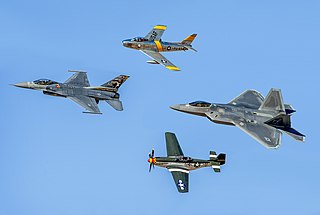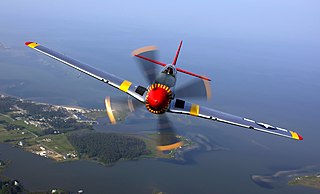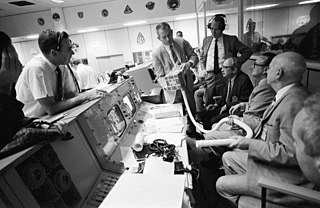
A military aircraft is any fixed-wing or rotary-wing aircraft that is operated by a legal or insurrectionary military of any type. Military aircraft can be either combat or non-combat:

The McDonnell Douglas YC-15 is a prototype four-engine short take-off and landing (STOL) tactical transport. It was McDonnell Douglas' entrant into the United States Air Force's Advanced Medium STOL Transport (AMST) competition to replace the Lockheed C-130 Hercules as the USAF's standard STOL tactical transport. In the end, neither the YC-15 nor the Boeing YC-14 was ordered into production, although the YC-15's basic design would be used to form the successful McDonnell Douglas C-17 Globemaster III.
Boeing Australia Holdings Pty Ltd, or simply Boeing Australia, is Boeing's largest subdivision outside the United States. Established in 2002, the company oversees its seven wholly owned subsidiaries, consolidating and co-ordinating Boeing's businesses and operations in Australia.

An airplane, or aeroplane, informally plane, is a fixed-wing aircraft that is propelled forward by thrust from a jet engine, propeller, or rocket engine. Airplanes come in a variety of sizes, shapes, and wing configurations. The broad spectrum of uses for airplanes includes recreation, transportation of goods and people, military, and research. Worldwide, commercial aviation transports more than four billion passengers annually on airliners and transports more than 200 billion tonne-kilometers of cargo annually, which is less than 1% of the world's cargo movement. Most airplanes are flown by a pilot on board the aircraft, but some are designed to be remotely or computer-controlled such as drones.

Friction stir welding (FSW) is a solid-state joining process that uses a non-consumable tool to join two facing workpieces without melting the workpiece material. Heat is generated by friction between the rotating tool and the workpiece material, which leads to a softened region near the FSW tool. While the tool is traversed along the joint line, it mechanically intermixes the two pieces of metal, and forges the hot and softened metal by the mechanical pressure, which is applied by the tool, much like joining clay, or dough. It is primarily used on wrought or extruded aluminium and particularly for structures which need very high weld strength. FSW is capable of joining aluminium alloys, copper alloys, titanium alloys, mild steel, stainless steel and magnesium alloys. More recently, it was successfully used in welding of polymers. In addition, joining of dissimilar metals, such as aluminium to magnesium alloys, has been recently achieved by FSW. Application of FSW can be found in modern shipbuilding, trains, and aerospace applications.

Safran S.A. is a French multinational company that designs, develops and manufactures aircraft engines, rocket engines as well as various aerospace and defense-related equipment or their components. It was formed by a merger between SNECMA and the defense electronics specialist SAGEM in 2005. Safran's acquisition of Zodiac Aerospace in 2018 significantly expanded its aeronautical activities.

A cargo aircraft is a fixed-wing aircraft that is designed or converted for the carriage of cargo rather than passengers. Such aircraft usually do not incorporate passenger amenities and generally feature one or more large doors for loading cargo. Freighters may be operated by civil passenger or cargo airlines, by private individuals or by the armed forces of individual countries.

Hellenic Aerospace Industry (HAI) is the leading aerospace company of Greece. The company headquarters is located in Tanagra, 65 kilometers north-west of Athens, with the industrial complex covering an area of 200,000 sq.m.
Magellan Aerospace Corporation is a Canadian manufacturer of aerospace systems and components. Magellan also repairs and overhauls, tests, and provides aftermarket support services for engines, and engine structural components. The company's business units are divided into the product areas of aeroengines, aerostructures, rockets and space, and specialty products. Its corporate offices in Mississauga, Ontario, Magellan operates in facilities throughout Canada, the United States, and the United Kingdom.

Aerosud is a group of companies with Aerosud Holdings as the parent company. The group is a South African aeronautical engineering and manufacturing company. Aerosud Aerospace was renamed Paramount Aerospace following its acquisition by Paramount Group and Aerosud Innovation and Training Centre (ITC) was incorporated in the AHRLAC Holdings Ahrlac of companies during a 2014 restructuring.

The Curtiss-Wright C-76 Caravan was an American all-wood military transport aircraft. The C-76 was intended as a substitute standard aircraft in the event of expected wartime shortages of light alloys. However, both prototype and production aircraft failed several critical flight and static tests, and after U.S. aluminum production proved sufficient for wartime defense requirements, orders for the C-76 were cancelled and production terminated.

Aerospace engineering is the primary field of engineering concerned with the development of aircraft and spacecraft. It has two major and overlapping branches: aeronautical engineering and astronautical engineering. Avionics engineering is similar, but deals with the electronics side of aerospace engineering.
Carbon fiber-reinforced polymers, carbon-fibre-reinforced polymers, carbon-fiber-reinforced plastics, carbon-fiber reinforced-thermoplastic, also known as carbon fiber, carbon composite, or just carbon, are extremely strong and light fiber-reinforced plastics that contain carbon fibers. CFRPs can be expensive to produce, but are commonly used wherever high strength-to-weight ratio and stiffness (rigidity) are required, such as aerospace, superstructures of ships, automotive, civil engineering, sports equipment, and an increasing number of consumer and technical applications.

The aircraft design process is a loosely defined method used to balance many competing and demanding requirements to produce an aircraft that is strong, lightweight, economical and can carry an adequate payload while being sufficiently reliable to safely fly for the design life of the aircraft. Similar to, but more exacting than, the usual engineering design process, the technique is highly iterative, involving high-level configuration tradeoffs, a mixture of analysis and testing and the detailed examination of the adequacy of every part of the structure. For some types of aircraft, the design process is regulated by civil airworthiness authorities.
Aircraft can have different ways to take off and land. Conventional airplanes accelerate along the ground until sufficient lift is generated for takeoff, and reverse the process to land. Some airplanes can take off at low speed, this being a short takeoff. Some aircraft such as helicopters and Harrier jump jets can take off and land vertically. Rockets also usually take off vertically, but some designs can land horizontally.

The AHRLAC is a South African light reconnaissance and counter-insurgency aircraft developed by AHRLAC Holdings, a joint venture between the Paramount Group and Aerosud. It is designed to perform as an inexpensive, more versatile substitute for unmanned aerial vehicles (UAVs) and modern light attack aircraft.
Carbon fiber testing is a set of various different tests that researchers use to characterize the properties of carbon fiber. The results for the testing are used to aid the manufacturer and developers decisions selecting and designing material composites, manufacturing processes and for ensured safety and integrity. Safety-critical carbon fiber components, such as structural parts in machines, vehicles, aircraft or architectural elements are subject to testing.
Stelia Aerospace is an aerospace company headquartered in Toulouse, France. It specializes in the design and manufacture of aerostructures, pilot seats and premium class passenger seats, mainly for the commercial aviation sector.

Aircraft recycling is the process of scrapping and disassembling retired aircraft, and re-purposing their parts as spare parts or scrap. Airplanes are made of around 800 to 1000 parts that can be recycled, with the majority of them made from metal alloys and composite materials. The two most common metal alloys are aluminum and titanium and the main composite material is carbon fiber.
An aluminum internal combustion engine is an internal combustion engine made mostly from aluminum metal alloys.













